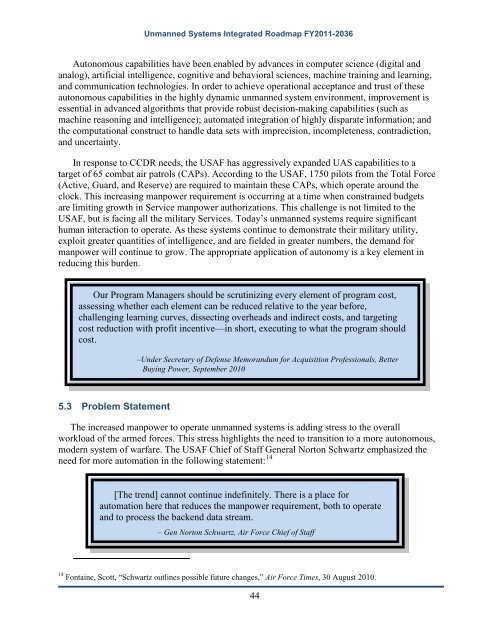Unmanned Systems Integrated Roadmap FY2011-2036 - Defense ...
Unmanned Systems Integrated Roadmap FY2011-2036 - Defense ...
Unmanned Systems Integrated Roadmap FY2011-2036 - Defense ...
You also want an ePaper? Increase the reach of your titles
YUMPU automatically turns print PDFs into web optimized ePapers that Google loves.
<strong>Unmanned</strong> <strong>Systems</strong> <strong>Integrated</strong> <strong>Roadmap</strong> <strong>FY2011</strong>-<strong>2036</strong><br />
Autonomous capabilities have been enabled by advances in computer science (digital and<br />
analog), artificial intelligence, cognitive and behavioral sciences, machine training and learning,<br />
and communication technologies. In order to achieve operational acceptance and trust of these<br />
autonomous capabilities in the highly dynamic unmanned system environment, improvement is<br />
essential in advanced algorithms that provide robust decision-making capabilities (such as<br />
machine reasoning and intelligence); automated integration of highly disparate information; and<br />
the computational construct to handle data sets with imprecision, incompleteness, contradiction,<br />
and uncertainty.<br />
In response to CCDR needs, the USAF has aggressively expanded UAS capabilities to a<br />
target of 65 combat air patrols (CAPs). According to the USAF, 1750 pilots from the Total Force<br />
(Active, Guard, and Reserve) are required to maintain these CAPs, which operate around the<br />
clock. This increasing manpower requirement is occurring at a time when constrained budgets<br />
are limiting growth in Service manpower authorizations. This challenge is not limited to the<br />
USAF, but is facing all the military Services. Today’s unmanned systems require significant<br />
human interaction to operate. As these systems continue to demonstrate their military utility,<br />
exploit greater quantities of intelligence, and are fielded in greater numbers, the demand for<br />
manpower will continue to grow. The appropriate application of autonomy is a key element in<br />
reducing this burden.<br />
Our Program Managers should be scrutinizing every element of program cost,<br />
assessing whether each element can be reduced relative to the year before,<br />
challenging learning curves, dissecting overheads and indirect costs, and targeting<br />
cost reduction with profit incentive—in short, executing to what the program should<br />
cost.<br />
5.3 Problem Statement<br />
–Under Secretary of <strong>Defense</strong> Memorandum for Acquisition Professionals, Better<br />
Buying Power, September 2010<br />
The increased manpower to operate unmanned systems is adding stress to the overall<br />
workload of the armed forces. This stress highlights the need to transition to a more autonomous,<br />
modern system of warfare. The USAF Chief of Staff General Norton Schwartz emphasized the<br />
need for more automation in the following statement: 14<br />
[The trend] cannot continue indefinitely. There is a place for<br />
automation here that reduces the manpower requirement, both to operate<br />
and to process the backend data stream.<br />
– Gen Norton Schwartz, Air Force Chief of Staff<br />
14 Fontaine, Scott, “Schwartz outlines possible future changes,” Air Force Times, 30 August 2010.<br />
44

















